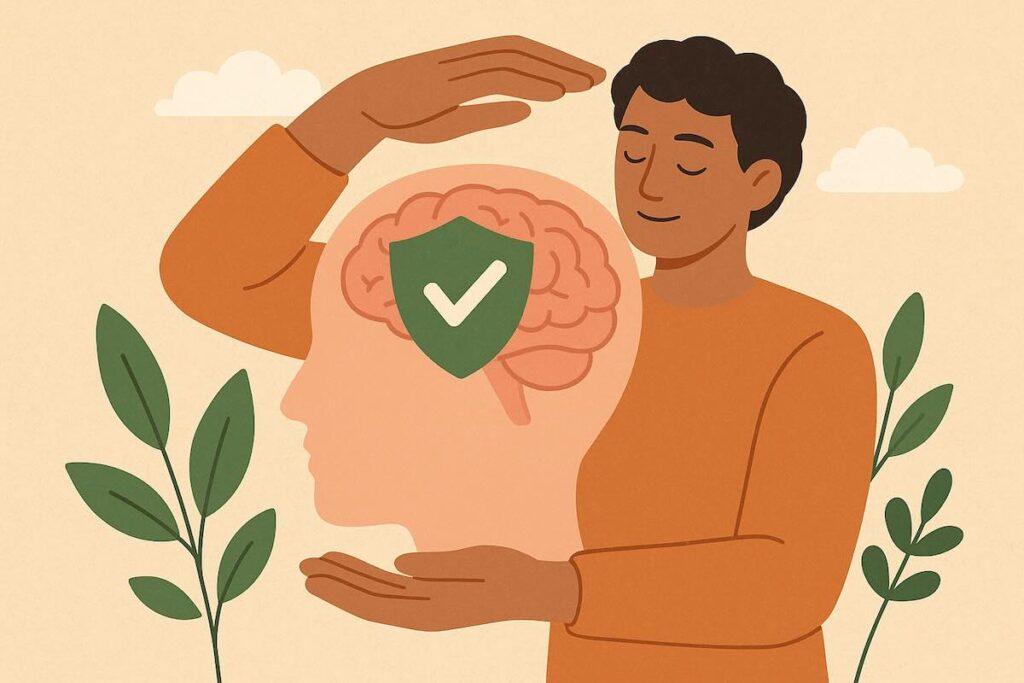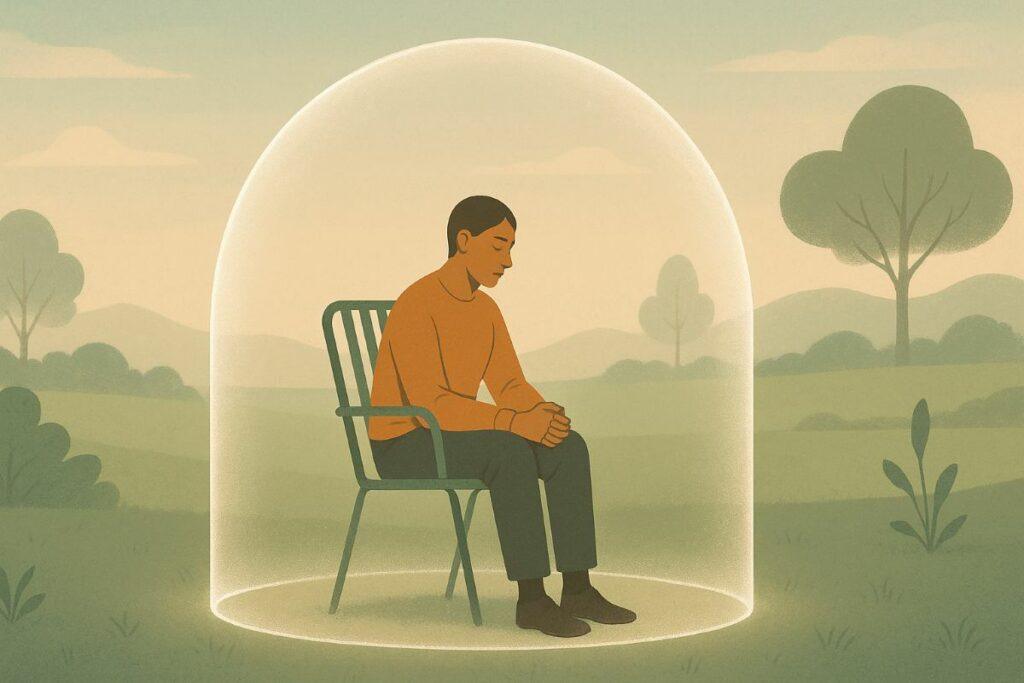Why do we shy away from change or honest talks? The Self-Preservation Mental Model sheds light on this. It’s based on how our brains protect us emotionally, socially, and physically.
Sometimes, this means we hold back from growing or being true to ourselves.
At work, we might dodge feedback or stick to old ways. In relationships, we might not speak up. The self-preservation model drives these choices. It’s like a guard that looks for threats to our image or energy. But it can get too alert, making small issues seem huge.
Knowing about this model helps us see our avoidance as a defense mechanism. It’s not always about being weak. It’s about when we should push past it for our own good.
This way, we can grow stronger and make better choices.
Key Takeaways
- Self-preservation mental model influences decisions beyond physical safety, including emotional and social risks
- It acts like an internal alarm system, sometimes triggering unnecessary caution
- Recognizing these patterns helps distinguish real threats from growth opportunities
- The model impacts professional choices, relationships, and personal development
- Balancing protection with adaptability leads to better long-term outcomes
By mapping how the self-preservation mental model operates, we gain power to rewrite its rules.
The following article will show practical ways to honor this instinct while expanding what feels safe – and possible.
Introduction to the Self-Preservation Mental Model
What drives people to resist changes that could benefit them in their life? At its core, this protective instinct acts like an invisible force field. It conserves energy by favoring familiar paths over new risks—even when old habits no longer serve us.
Consider workplace dynamics: 70% of organizational shifts fail because teams fear uncertainty. Employees might avoid proposing ideas or cling to outdated processes. This tendency isn’t laziness—it’s an evolutionary relic prioritizing stability over growth.
| Survival Instinct | Modern Equivalent | Impact |
|---|---|---|
| Avoiding physical danger | Resisting job changes | Stagnation in career growth |
| Conserving energy | Repeating ineffective routines | Missed innovation opportunities |
| Protecting social status | Over-editing social media posts | Reduced authentic connection |
These patterns show up in subtle ways. A manager delays feedback to prevent conflict. A colleague hesitates to ask for help, fearing judgment. Each choice prioritizes short-term comfort over long-term progress.
Recognizing these behaviors helps us reframe them. Instead of viewing resistance as weakness, we see it as a natural part of human psychology. The challenge lies in distinguishing genuine threats from imagined ones—like knowing when to heed a smoke alarm versus ignoring a false alert.
The Origins and Definition of Self-Preservation

Our ancestors didn’t overthink survival—their bodies reacted before conscious thought kicked in. Neuroscientists trace this instinct to the amygdala, a brain region triggering fight-or-flight responses.
When early humans faced predators, their pulse quickened and muscles tensed without effort. These automatic biological survival mechanisms still shape our daily actions.
Eating breakfast isn’t just about hunger. It’s your nervous system conserving energy for potential challenges—the same drive that makes drivers slow down during storms.
This protective wiring operates like a smoke detector of the mind. It scans for threats to physical safety, social standing, or emotional security.
Modern life transforms these impulses. Avoiding tough conversations mirrors our ancestors’ conflict evasion. Overworking to prove worth replicates tribal status-seeking. Though environments changed, the sense of danger remains wired into our biology.
For example, in many cases, the way we handle these problems reflects the time-tested instincts of survival.
Consider how this plays out:
- Loyalty to unfulfilling jobs (territorial protection)
- Perfectionism in projects (fear of exclusion)
- Reluctance to delegate tasks (resource hoarding)
These behaviors aren’t flaws—they’re evolutionary relics. Recognizing them helps separate genuine risks from outdated alarms. The thing that kept cave dwellers alive now shapes boardroom decisions and social media habits.
The Psychology Behind Self-Preservation
Imagine your palms sweating before a presentation, or your mind racing when asked for feedback. These reactions trace back to ancient wiring—a system designed to shield us from harm.
Today, this instinct guards more than physical safety. It defends our sense of worth, social standing, and emotional stability.
Biological Instincts and the Fight-or-Flight Response
Your body’s alarm system activates faster than conscious thought. When facing criticism or deadlines, the amygdala triggers a surge of adrenaline—the same response that once helped dodge predators. Heartbeats quicken. Muscles tense. But modern stressors—like public speaking or tough conversations—don’t require sprinting or fighting.
This mismatch explains why we freeze during Zoom calls but feel no urge to flee. The brain prioritizes immediate protection over long-term growth. Research shows 83% of professionals experience this stress reaction weekly, often mistaking social risks for survival threats.
Emotional Health and Ego Protection
We avoid vulnerability not from weakness, but to conserve emotional resources. Declining a promotion to avoid scrutiny or withholding opinions to prevent conflict—these choices prioritize ego safety. Like a castle drawbridge, the mind raises barriers when it senses judgment.
Consider how perfectionism stifles creativity. Teams over-edit proposals, fearing imperfect performance. Individuals delay sharing ideas, worried about flawed information. Each decision trades potential growth for temporary comfort.
How might you differentiate between genuine danger and imagined threats? Notice when avoidance patterns surface. Is the risk real, or is your nervous system sounding a false alarm?
How the Self-Preservation Mental Model Affects Decision-Making Under Pressure
When we face tight deadlines, high-stakes meetings, or emotional confrontations, our brain goes into protective mode. The self-preservation mental model helps us stay safe in dangerous situations. It also affects whether we speak up, take action, or stay quiet in tense moments.
Research in behavioral economics and decision science shows that stress makes us choose short-term safety over long-term gains. This is why some people shy away from conflict, even if it could lead to better outcomes. Leaders might also delay making tough decisions, fearing negative reactions.
This fear of change is rooted in loss aversion. It makes the familiar seem safer than the unknown, even if the unknown could be better. To overcome this, we need to become more aware of our thoughts and feelings.
Practicing “cognitive distancing” is helpful. It involves acknowledging our fears without acting on them. This allows us to think more clearly about what’s really important. The aim is not to ignore the warning signs but to understand them better.
Self-Preservation in Everyday Life

Daily choices often reveal more about our protective wiring and the factors influencing our decisions than we realize. From muted opinions in meetings to polished social media feeds, survival instincts shape modern behavior in unexpected ways, highlighting the system we navigate daily.
Practical Examples in Work and Social Settings
Four out of ten employees admit withholding ideas fearing criticism—a flight response disguised as professionalism. Teams default to “safe” solutions, leaving bolder innovations unexplored. This pattern appears in casual interactions too. Ever cancel plans last-minute to avoid draining conversations? Your body might signal exhaustion before your mind acknowledges it.
Social Media Behavior and Curation
Platforms magnify protective tendencies. Users spend 18 minutes average editing posts—trimming authenticity to dodge judgment. A vacation photo becomes a performance. Comments get overanalyzed. Each polished update reinforces the belief that vulnerability risks social standing.
Spotting these patterns helps individuals make conscious decisions. Track moments when:
- You rehearse simple requests excessively
- Feedback conversations trigger physical tension
- Social interactions leave lasting fatigue
These signs reveal where protective instincts might override growth opportunities. Small adjustments—like sharing unfinished ideas or posting unedited experiences—gradually expand comfort zones. What day-to-day habit could you reshape to balance safety with authenticity?
The Impact on Organizational Change and Innovation
Seven out of ten transformation initiatives collapse before reaching their goals. Why? Teams often prioritize safety over progress when facing unfamiliar territory. This invisible force field of caution shows up in delayed decisions, watered-down proposals, and silent conference rooms filled with unspoken ideas.
Self-Preservation and Leadership Blind Spots
Executives and managers can fall into the same trap as frontline staff. They might resist new technologies or refuse feedback to keep control. This behavior can affect the whole team.
Research from Harvard Business Review shows leaders often prioritize keeping their power. This “power preservation bias” can stop innovation and hurt team morale. It also means they miss out on big chances for change.
To fight this, it’s important to teach leaders about psychological safety. Creating systems for peer review and using anonymous feedback can help. These steps can open their eyes to their own biases.
Fear of Uncertainty and Employee Resistance
Workplaces function like ecosystems—any shift disrupts established routines. Research reveals 68% of employees withhold suggestions fearing negative reactions. A marketing team might stick with outdated campaigns because “what works” feels safer than testing new concepts. This hesitation costs companies up to 40% in lost innovative potential annually.
| Protective Behavior | Organizational Impact | Hidden Cost |
|---|---|---|
| Withholding feedback | Missed process improvements | 15% productivity loss |
| Reusing old strategies | Stale customer engagement | 23% revenue decline |
| Avoiding cross-department collaboration | Siloed information flow | 30% longer project timelines |
How Innovation Can Decline Due to Risk Aversion
Creative thinking thrives where curiosity outweighs caution. Yet many teams default to proven ways of operating—like using last year’s successful pitch deck instead of experimenting with new formats. These beliefs can become a part of the challenges faced when trying new things.
A tech company’s reluctance to test emerging AI tools could let competitors dominate the market within months.
Leaders can counteract this trend by:
- Rewarding calculated risks as much as successes
- Creating “safe failure” zones for experimental projects
- Publicly acknowledging imperfect attempts
One healthcare firm increased implemented ideas by 210% after introducing anonymous suggestion channels. When protection instincts shift from individual safety to collective growth, organizations unlock their true capacity for change.
What small step could your team take today to balance security with exploration?
Social Self-Preservation Theory: Image Versus Vulnerability

Six in ten people bite their tongue during group discussions. They fear judgment more than they value authenticity. This silent epidemic of self-censorship drains relationships and personal growth.
Consider Sarah—a team leader who nods through meetings while disagreeing internally. Her polished LinkedIn posts hide career doubts.
These behaviors mirror ancient tribal instincts: sacrificing truth to maintain group standing. Modern life turns survival into smiley-face emojis and half-hearted agreements.
| Protective Action | Immediate Relief | Long-Term Problem |
|---|---|---|
| Laughing at offensive jokes | Avoids confrontation | Erodes self-respect |
| Over-editing social media posts | Gains likes | Creates false connections |
| Silencing political views | Prevents arguments | Stifles meaningful dialogue |
This pattern shows up in subtle ways. A person might ghost friends instead of addressing conflicts. Professionals adopt office slang to fit in, masking their true communication style. Each choice trades temporary comfort for genuine connection.
Breaking the cycle starts with small actions. Share one unpopular opinion this week. Let a photo go unedited. Notice when people-pleasing drains your energy versus when it builds bridges. Where could guardedness be costing you more than it protects?
The Self-Preservation Trap in Chronic People-Pleasing
People-pleasing might seem like being polite or caring, but it can also hide a need to protect oneself. Saying “yes” to avoid trouble or hiding your needs to keep approval can keep things calm in the short term.
But, it can also take away your true self in the long run.
This behavior is common in places where speaking up is seen as risky. Over time, those who always try to please others may forget what they truly believe.
This can lead to feeling overwhelmed, exhausted, and unsure of who they are. The first step is to notice this pattern in ourselves.
Starting to be more direct in safe situations can help. It’s a way to slowly learn to express ourselves honestly, not just to avoid trouble.
Self-Preservation Mental Model in Negotiations and Interpersonal Relationships
Why do negotiators walk away from beneficial deals? Often, it’s not the terms that fail—it’s the fear of appearing vulnerable. This instinct to protect social standing shapes both boardroom discussions and family dinners.
Risk Aversion in Negotiation Dynamics
Research shows 42% of professionals reject advantageous offers to avoid seeming inexperienced. A sales director might refuse flexible payment terms—not because they’re harmful, but to maintain perceived authority. This pattern mirrors studies on concession aversion, where protecting ego outweighs measurable gains.
| Protective Action | Immediate Benefit | Long-Term Cost |
|---|---|---|
| Rejecting beneficial deals | Avoids looking weak | Missed partnerships |
| Withholding concerns | Prevents conflict | Erodes trust |
| Overpromising results | Maintains image | Causes burnout |
Maintaining a Positive Public Image
Social media amplifies this struggle. People spend 22% more time crafting professional updates than personal ones—curating perfection while silencing true feelings. A manager might praise flawed plans to seem agreeable, delaying crucial feedback.
Try this: Before your next negotiation, ask, “Am I guarding my ability to succeed or my image?” Small shifts—like admitting knowledge gaps—often build rapport faster than polished expertise. Where could authenticity strengthen your relationships instead of weakening them?
Role of Self-Preservation in Mental Health and Well-Being

Your daily energy management holds hidden clues about emotional safety needs. That afternoon nap craving? The sudden urge to cancel plans?
These signals reveal how protective instincts operate beneath conscious awareness—guarding psychological resources as fiercely as physical ones.
Self-Preservation Mental Model: Spot Burnout Before It Strikes
Chronic fatigue often masquerades as temporary stress. Research shows it takes workers 2.3 years on average to recognize burnout patterns. Watch for these signs:
- Irritation over minor changes
- Decision fatigue during simple tasks
- Physical symptoms like headaches
These markers signal your flight response activating—not from danger, but emotional overload. A teacher might dread parent meetings despite loving their job. A nurse could feel nauseous before shifts. The body speaks when words fail.
Boundaries That Build Resilience
Healthy limits act like emotional air traffic control. They direct energy to what matters while preventing collisions. Consider:
| Unhealthy Protection | Strategic Boundary |
|---|---|
| Ignoring texts for days | “I respond within 24 business hours” |
| Working through lunch | “Protected meal breaks daily” |
| Over-sharing to please others | “I’ll think about that and circle back” |
Pay attention to what drains versus sustains you. That colleague who leaves you exhausted? Maybe shorter check-ins work better. The project causing Sunday night dread? Perhaps it needs reshaped—or released.
Self-Preservation and the Growth Mindset Conflict
There’s a natural tension between the self-preservation mental model and the growth mindset. One looks for safety and predictability. The other grows by facing challenges, failures, and uncertainty.
Carol Dweck’s research in psychology reveals a key point. People with a growth mindset are more likely to take risks and learn from mistakes. But, when self-preservation takes over, the brain sees these risks as threats to self-worth or social standing.
This can lead people to avoid opportunities that could help them grow or improve.
To change this, we can make failure a normal part of progress. Leaders who share their failures, or teams that discuss both wins and losses, help reduce fear of growth. This encourages behavior that supports long-term growth over short-term safety.
Self-Preservation vs. Self-Care: Distinguishing Healthy Behaviors

Think of your well-being as a house. Self-preservation builds the foundation—strong enough to withstand storms but flexible enough to expand. Self-care paints the walls, choosing colors that spark joy. Together, they create spaces where life flourishes.
Healthy protection means setting boundaries that conserve energy for what matters. It’s saying “no” to toxic work projects so you can say “yes” to family time. Unlike avoidance—which shrinks your world—true preservation strengthens your capacity to engage fully.
| Protective Tendency | Intentional Care | Outcome |
|---|---|---|
| Isolating when stressed | Scheduling quiet recovery days | Renews energy for connection |
| Overworking to prove worth | Protecting creative thinking time | Sustains innovation |
| Silencing needs to please others | Communicating clear preferences | Builds authentic relationships |
Notice the difference? One approach drains—the other fuels. A common tendency involves mistaking survival mode for self-care. True preservation combines strategic self-care practices with courageous growth steps.
Ask yourself: Do my daily choices feel like armor weighing me down—or tools helping me thrive? The answer reveals whether you’re building walls or bridges.
Start small. Replace one draining habit this week with an action that both protects and empowers.
Cognitive Biases: Denial, Rationalization, and Self-Justification
Why do smart people cling to choices that hurt them? Our brains often twist reality to protect our self-image—a silent tug-of-war between truth and comfort.
Three hidden patterns shape this behavior:
- denying uncomfortable facts,
- crafting logical-sounding excuses,
- defending past actions.
The Cycle of Self-Justification in Daily Decisions
Imagine buying an expensive gadget you rarely use. First comes denial—”I’ll definitely need this later.” Then rationalization—”It’s an investment in productivity.” Finally, self-justification—”I earned this treat.”
This pyramid pattern locks us into harmful patterns at work and home.
A manager might ignore team feedback (denial), claim “consistency matters more” (rationalization), then double down on flawed strategies (self-justification).
Each step feels easier than admitting mistakes—but costs progress.
Breaking the cycle takes effort. Start by asking: “What evidence contradicts my view?” Track moments when excuses surface. Small truth-telling actions weaken biased thinking over time.
What protective story have you been telling yourself that no longer serves you?
Conclusion
The Self-Preservation Mental Model is not a flaw—it’s a feature of human psychology designed to protect us. But when that protection becomes overactive, it limits our growth, blocks honest talks, and hinders progress.
By recognizing the signs—hesitation, burnout, silence, avoidance—we can take back control. Mental models like this one help us step back, identify the issue, and choose a better path.
Whether leading a team, navigating relationships, or growing personally, learning to balance self-preservation with courage is essential.
The aim isn’t to get rid of your safety instinct. It’s to train it to help you, not hold you back.


